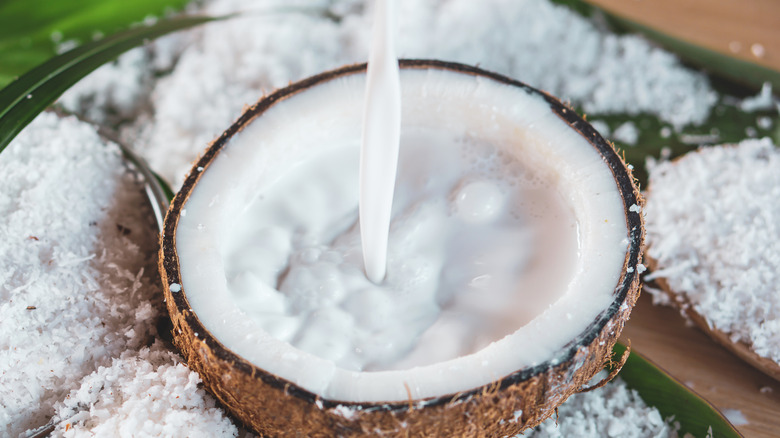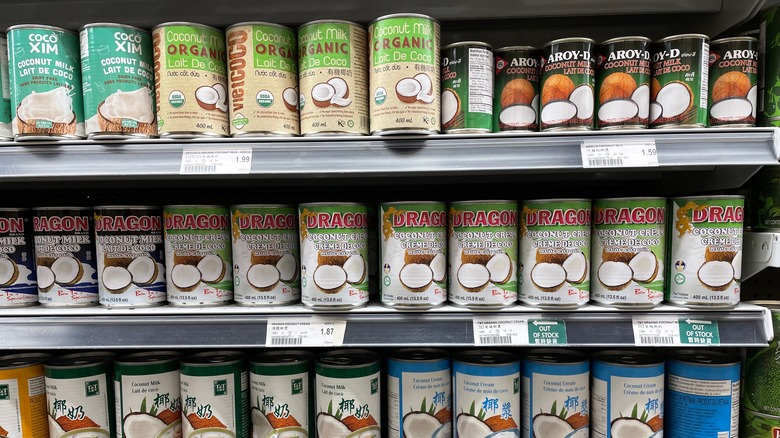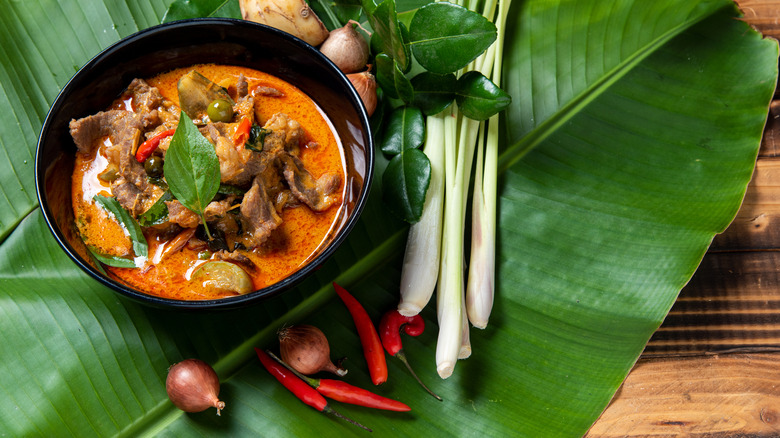What You Need To Know Before Adding Canned Coconut Milk In A Recipe
There are some ingredients a cook should always have around. Cooking oils and spices are as essential as salt, but let's not underestimate the versatility of mustard, the longevity of dried grains, or how a can of beans and a can of diced tomatoes is really all you need for a fast weeknight dinner. Whenever you run out of these staples, buy two or more — you'll thank yourself later. A well-stocked larder can give you peace of mind for emergencies, whether they're of the culinary kind or natural disasters that leave you without power.
One of the most flexible pantry goods to keep handy is a can of coconut milk. You never know when you'll be in the mood for a Thai or Indian dish or perhaps in need of a shelf-stable dairy-free milk substitute. BBC Good Food notes that versatile coconut milk tempers the heat of curries, thickens up soups, sweetens baked goods, and is absolutely necessary for coconut rice. But before you dash off triumphantly to at last fulfill your coconut milk's destiny, understand that the canned stuff (and its uses) are not all the same!
Check if your coconut milk is sweetened or unsweetened
Coconut milk, as defined by MasterClass, is made from the meat of the coconut combined with water. As such, it has a rich dairy-like consistency and can be used as a substitute for regular milk in many recipes, particularly if it's unsweetened and full-fat (the most common canned variety). This is the culinary go-to; it's not typically sweetened because the coconut is naturally sweet, per Kitchen Appliance HQ. While you can always add your sweetener of choice to your dish, you can't remove it once it's been added, so it's a good practice to make sure your recipe doesn't specifically require sweetened coconut milk first.
However, you'll sometimes encounter lite coconut milk, with 60% less fat than the full-fat kind. This will be thinner and, therefore, not suited for thick sauces and creamier dishes. There's also something called "coconut milk beverage," which is intended to be used like almond milk and other plant-based milks and made from coconut, water, and additional ingredients for an easily-drinkable product. MasterClass also explains that canned coconut milk differs from coconut cream, which contains less water and is often watered down before use, and cream of coconut, which is a very sweet blend of coconut, sugar, and water for making cocktails.
How to use canned coconut milk
It's easy to cook with canned coconut milk. Martha Stewart says you may crack open a can and find it has separated into two layers and must be stirred before use. Organic Authority recommends purchasing organic coconut milk whenever possible and points out that the ingredient guar gum you might see on the label is a harmless bean-based powder added as a stabilizer in many foods. Incorporating coconut milk into your diet is a good way to add healthy fats (especially medium-chain triglycerides), proteins, and minerals and possibly aid in weight loss and cholesterol balance, per Healthline. Just be sure to use your coconut milk within a week, as it does expire.
With this in mind, there's a diversity of dishes to be made with a can of coconut milk. Pair it with a can of pureed pumpkin for a satisfying Vietnamese pumpkin soup — or try Chef Brooke Baevsky's no-bake pumpkin mousse (via Newsweek). It's fast to make but be sure to chill your coconut milk ahead of time, according to the article. Build layers of flavor and texture with Michelin Guide's Thai green curry recipe and Food Network's chicken satay-style with couscous. Good Housekeeping praises coconut milk in everything from ice cream and popsicles to lentils and salmon. All you'll need is a can opener — consider your culinary possibilities enriched.


